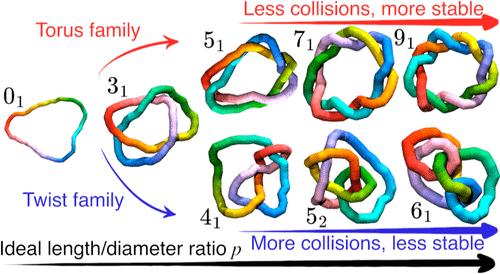Effects of Knotting on the Collapse of Active Ring Polymers
IF 5.2
1区 化学
Q1 POLYMER SCIENCE
引用次数: 0
Abstract
We use numerical simulations to study tangentially active flexible ring polymers with different knot topologies. Simple, unknotted active rings display a transition from an extended phase to a collapsed one upon increasing the degree of polymerization. We find that topology has a significant effect on the polymer size at which the collapse takes place, with twist knots collapsing earlier than torus knots. Increasing knot complexity further accentuates this difference, as the collapse point of torus knots grows linearly with the minimum crossing number of the knot while that of twist knots shrinks, eventually canceling the actively stretched regime altogether. This behavior is a consequence of the ordered configuration of torus knots in their stretched active state, featuring an effective alignment for non-neighboring bonds which increases with the minimal crossing number. Twist knots do not feature ordered configurations or bond alignment, increasing the likelihood of collisions, leading to collapse. These results show that topology yields a degree of control on the properties of active ring polymers, and can be used to tune them. At the same time, they suggest that activity might introduce a bias for torus knots, as complex twist knots cannot be formed in extended active polymers.

打结对活性环聚合物坍塌的影响
本文采用数值模拟方法研究了具有不同结拓扑结构的切向活性柔性环聚合物。简单的,未结的活性环在增加聚合度时显示从延伸相到崩溃相的转变。我们发现拓扑结构对聚合物尺寸有显著的影响,在聚合物尺寸发生坍塌时,扭转结比环面结更早坍塌。增加结的复杂性进一步强调了这种差异,因为环面结的崩溃点随着结的最小交叉数线性增长,而扭转结的崩溃点则缩小,最终完全取消了主动拉伸状态。这种行为是环面结在其拉伸活性状态下的有序配置的结果,具有非相邻键的有效排列,并随着最小交叉数的增加而增加。扭结不具有有序的结构或键对齐,增加了碰撞的可能性,导致崩溃。这些结果表明,拓扑结构对活性环聚合物的性质产生了一定程度的控制,并可用于调整它们。与此同时,他们认为活性可能会导致环面结的偏向,因为复杂的扭转结不能在延伸的活性聚合物中形成。
本文章由计算机程序翻译,如有差异,请以英文原文为准。
求助全文
约1分钟内获得全文
求助全文
来源期刊

Macromolecules
工程技术-高分子科学
CiteScore
9.30
自引率
16.40%
发文量
942
审稿时长
2 months
期刊介绍:
Macromolecules publishes original, fundamental, and impactful research on all aspects of polymer science. Topics of interest include synthesis (e.g., controlled polymerizations, polymerization catalysis, post polymerization modification, new monomer structures and polymer architectures, and polymerization mechanisms/kinetics analysis); phase behavior, thermodynamics, dynamic, and ordering/disordering phenomena (e.g., self-assembly, gelation, crystallization, solution/melt/solid-state characteristics); structure and properties (e.g., mechanical and rheological properties, surface/interfacial characteristics, electronic and transport properties); new state of the art characterization (e.g., spectroscopy, scattering, microscopy, rheology), simulation (e.g., Monte Carlo, molecular dynamics, multi-scale/coarse-grained modeling), and theoretical methods. Renewable/sustainable polymers, polymer networks, responsive polymers, electro-, magneto- and opto-active macromolecules, inorganic polymers, charge-transporting polymers (ion-containing, semiconducting, and conducting), nanostructured polymers, and polymer composites are also of interest. Typical papers published in Macromolecules showcase important and innovative concepts, experimental methods/observations, and theoretical/computational approaches that demonstrate a fundamental advance in the understanding of polymers.
 求助内容:
求助内容: 应助结果提醒方式:
应助结果提醒方式:


